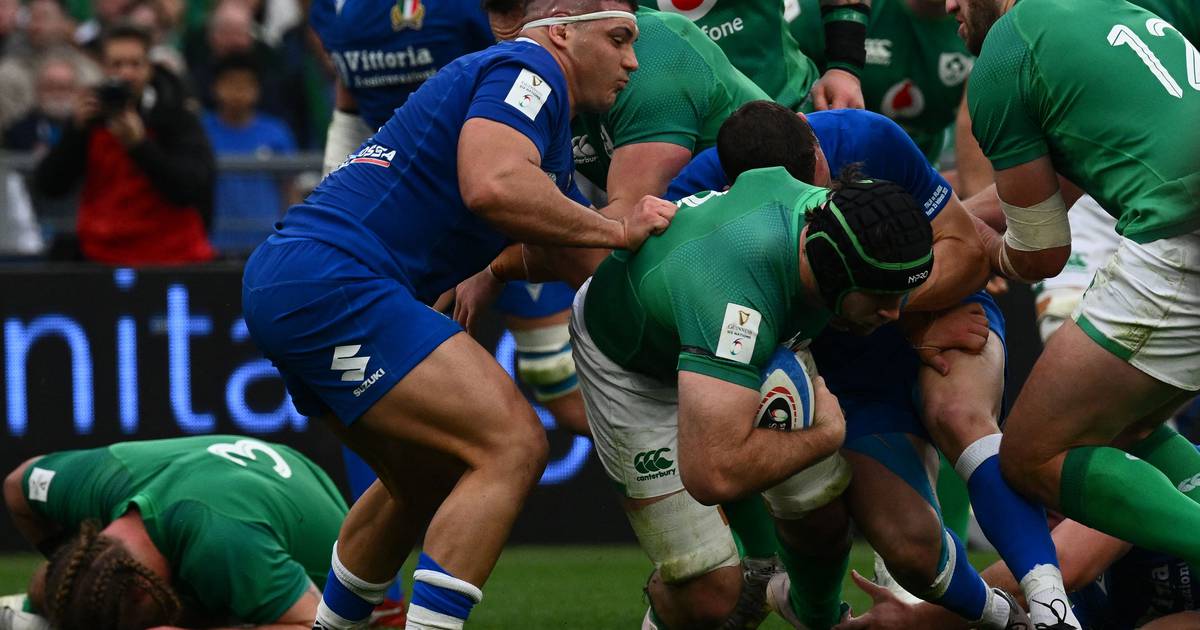Statistics are malleable, so here goes. Ireland managed a mini-milestone at the Stadio Olimpico in winning 100 per cent of their attacking rucks, a feat only once previously achieved in the Six Nations during the current World Cup cycle, by France against Wales (2021). Andy Farrell’s side stole the ball on seven occasions at the breakdown, won 11 turnovers in total and made nine line-breaks from which they scored five tries.
That’s a synopsis of some statistical minutiae that would suggest a decent attacking shape and performance, especially in acknowledging that the visitors in Rome left several tries behind in the in-goal area.
The visual perspective offers a little contradictory evidence. Initially, a large tranche of Ireland’s carrying up front looked a little laboured and pedestrian, with a knock-on effect being a struggle to get over the gain-line. It was only with the introduction of players from the bench and a re-shaped team that Ireland managed to get more purchase in that facet of the game.
There is a strong argument that Ireland were a more accomplished attacking team when Peter O’Mahony came on at blindside flanker and Caelan Doris switched to number eight. The net effect was obvious both in a general sense but also specifically in the build-up play to Mack Hansen’s second try.
There were other contributory factors: Conor Murray’s governance when coming on at scrumhalf; the energy and athleticism of Ryan Baird and Dan Sheehan; and the fact that the game broke open a little more after 56-minutes, a byproduct of tiring minds and legs.
This is not to lay anything at Jack Conan’s door per se, as he too might have prospered with the alterations. Doris did, though, as he was restored to his favoured position, and that’s likely to be reflected in the composition of the backrow for Sunday’s Six Nations clash against Scotland at Murrayfield.
The 24-year-old Doris has won 26 Ireland caps, 15 at number eight, 10 at blindside flanker and one when coming on as a replacement. His innate ability allows him to straddle both positions but if Ireland are to win in Edinburgh, it will not be about being good, players will need to be great individually and collectively in the position that allows them to fully express their talent.
Doris’ numbers dating back to the three Test series in New Zealand last summer show 79 tackles, 78 carries, 12 defenders beaten, one try from nine appearances, seven at number eight, and two, against Fiji and Italy, at blindside flanker. He is the form number eight in Test rugby available to the national side.
Part of the equation must embrace the roles that O’Mahony and Van der Flier play, producing not only high-level contributions on their own but providing a balance to the backrow in discharging duties: square pegs in square holes, so to speak.
That familiarity is vital in the white heat of the match environment where players are struggling to breathe, let alone think, and where instinct and good habits are crucial to a successful outcome. The struggle for supremacy at the breakdown will have a massive bearing on the outcome of Sunday’s game.
It’s an area that highlights a slightly different emphasis for the protagonists at Murrayfield. In Scotland’s 29-23 victory over England at Twickenham, Scotland spent just one minute and 44 seconds in the England 22, managed premium ruck speed (0-3 seconds) 65.8 per cent of the time and managed to slow down England’s speed (over six seconds) 24.6 per cent of the time with a backrow of Jamie Ritchie (seven carries, 13 tackles), Luke Crosbie (four, 20) and Matt Fagerson (nine, 28).
In a 35-7 win over Wales, Gregor Townend’s team had a premium ruck speed (0-3 seconds) of 73.7 per cent and against France, a match they lost, it dropped to 60 percent, with the six-plus-second rucks up at 17.2 per cent.
By way of comparison Ireland produced figures of 58.7 per cent (v Wales), 65.4 per cent (v France) and 57.1 per cent (v Italy) for the 0-3 second rucks, much lower than next Sunday’s rival but also Farrell’s team are happy to take their opponents through multiple phases and breakdowns in maintaining possession.
In their three matches to date, the Scots have won 229 and lost nine rucks. The Irish numbers are 333 and 10. Scotland’s offloading game is a factor here, while less obvious is the fact that their strike plays have been very effective and don’t need to rack up the rucks to make progress. Oh, and their ruck speed in the final third of the pitch has been below 1.5 seconds during Townsend’s time. Warp speed.
Farrell’s side average over 30 more rucks per game; it requires a huge amount of patience and precision, giving the opposition more chances to poach and the referee more opportunities to interpret a team’s actions (sealing off, etc) and to intervene at the breakdown.
Ireland can shift when the mood takes them, their average ruck speed in Rome was 2.88 seconds; no other country got below three seconds during that third weekend of the tournament. So, what will the Scots try to do at Murrayfield this weekend?
[ Gerry Thornley: Six players who have caught the eye in the Six Nations ]
They know that if Ireland dominate possession that will be reflected in the number of attacking rucks. The Scots must pick and choose moments.
Ireland’s perfect score in Rome (94-0, attacking rucks won) won’t be replicated but they’ll have to try to go as close as possible. To do that there is a job for everyone and everyone must know it intimately.
Picking players in their best positions will be an important part of achieving this but also in providing Farrell’s side with those moments of attacking cohesion that can make the difference.



